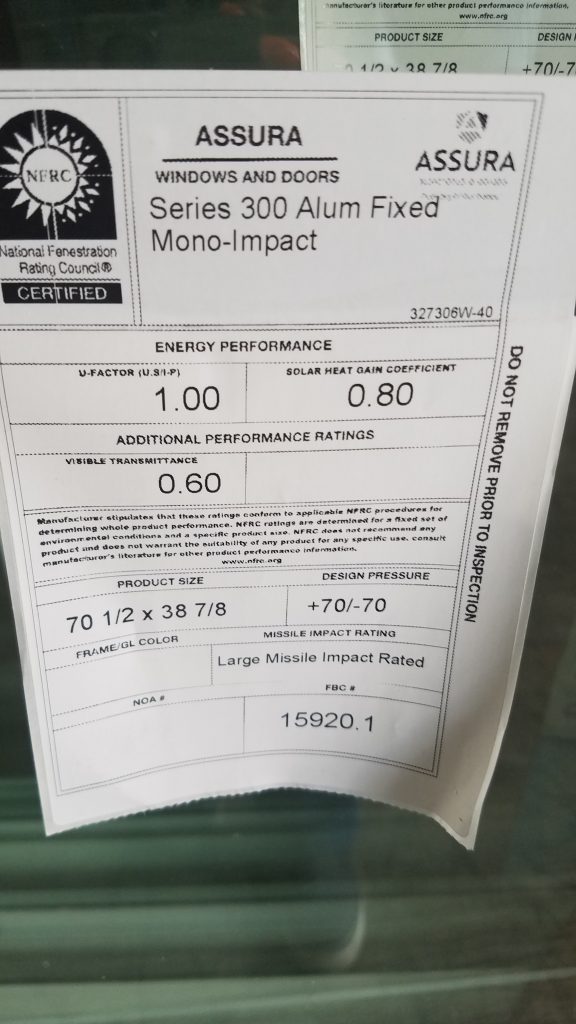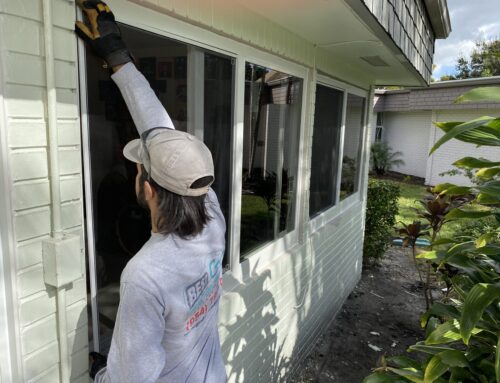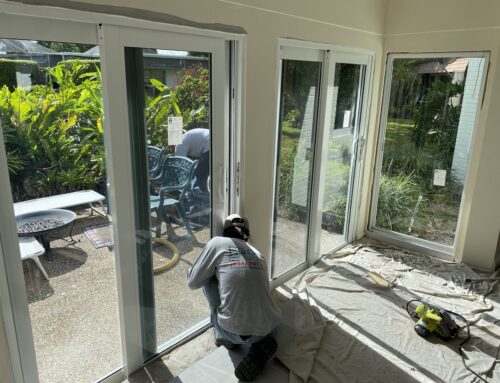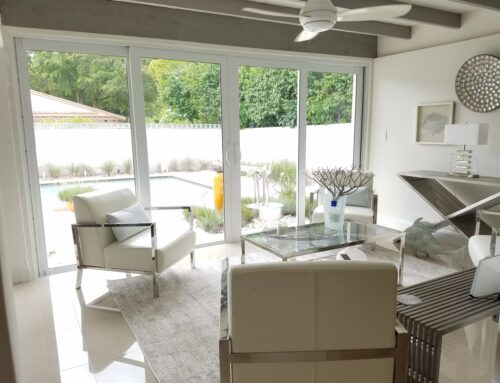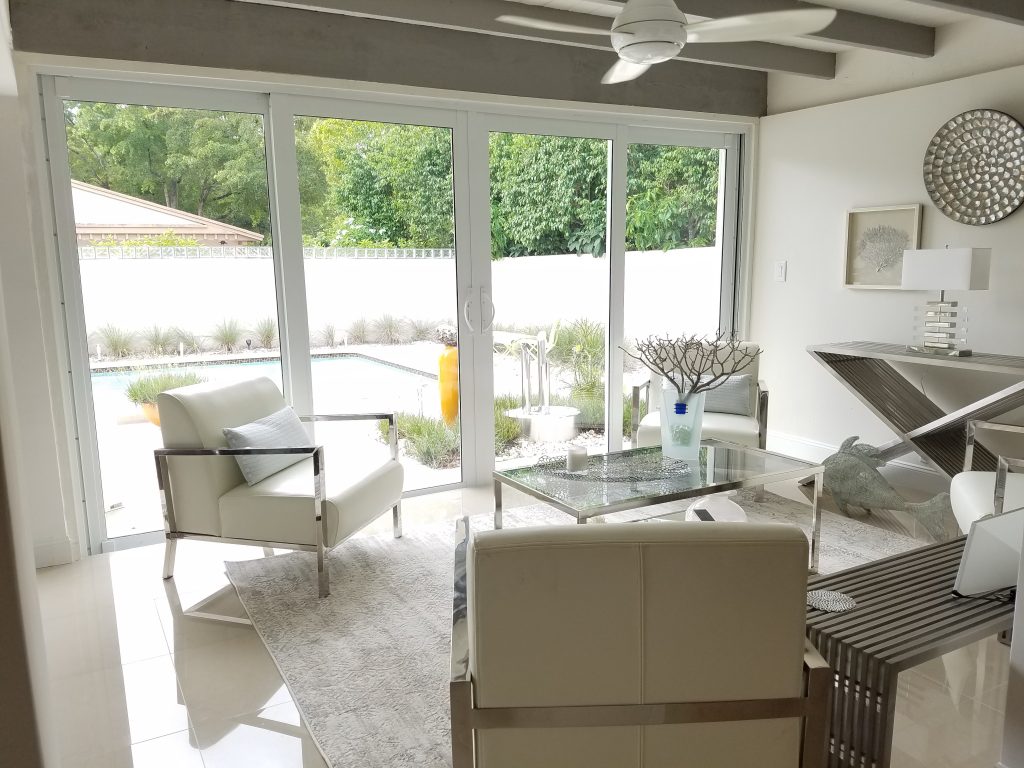
Replacement windows are subject to current building codes and require a building permit. In South Florida, a window’s function is not just to allow light and air into the home but can be a safety measure in the event of a storm. One should seriously look at adding impact windows, also known as hurricane windows, to receive protection from storms and many more benefits. An impact window in a Florida home has a multi-functional role: it must allow the sun’s light to pass through, but not the sun’s heat; it must keep cool conditioned air inside but not allow condensation to form on the surface of the glass. It must not allow hot, humid outside air to leak into the home in summer, nor allow warm inside air to leak out of the house in winter. Plus, as a result of Hurricane Andrew in 1992, we know hurricanes can breach older windows, making them a primary access point for wind, rain, and wind-borne debris.
Florida Building Code (FBC)
The FBC requires windows to be impact-resistant or protected with shutters if located within one mile of the coast where the wind speed is 140 mph or greater during a storm. (Of course, even if your home is not located in this area, impact windows are getting to be the norm in all of South Florida.) A window is a complex system, and it’s more than just glazing (glass): it also includes the frame, sash, and any operable elements as well.
Florida Building Code prescribes performance and construction requirements for exterior windows and glass doors installed in-wall systems. Testing by an approved testing laboratory is required. Approved labels affixed to the window must identify the manufacturer, performance characteristics approved product certification agency, testing laboratory, evaluation entity, or Miami-Dade notice of acceptance (NOA). To pass inspection, the city inspector must view this sticker affixed to your windows, so make sure not to remove the sticker before the inspection. And the answer is yes to the question, “Do I need a permit to install impact windows?”
There are testing standards set forth by the American Society for Testing & Materials (ASTM) and/or others that must be met before a window is certified as being impact-resistant. One of the most stringent testing requirements is referenced in the High-Velocity Hurricane Zone (HVHZ) section of the Florida Building Code, which applies to Miami-Dade and Broward Counties. To pass inspection and be eligible for insurance discounts, every exterior opening, residential or commercial, must be protected by shutters or impact-resistant windows against wind-borne debris caused by hurricanes in the HVHZ. A company may have its products approved for local or state use. Broward and Miami-Dade Counties have the strictest test protocols in the country for wind-borne debris, positive and negative air pressure, and water tests.
Impact-Resistant Glazing
Impact-resistant glazing is available as laminated glass and is also considered a type of safety glazing. Laminated glass consists of two or more panes of clear glass bonded together with transparent plastic-like film (usually polyvinyl butyral) sandwiched between the two. This inner “filling” ranges in thickness from .015 to .090 inches, which can be ordered in various colored tints to help reduce UV damage in the home. The laminated glass does not shatter but holds hold the glass together upon impact. If cracked or broken, the glass fragments adhere to the plastic interlayer, thus preventing water, wind, or wind-borne debris from entering the structure. Note that the frames for laminated glass are generally beefier than for regular residential windows because although the glass may not break, a strong force could hit the window hard enough to cause the entire frame to give way. The window is tested as a unit that includes the glass, frame, attachment hardware, and the installation method when undergoing testing. Products designed to protect your home’s openings must be both tested and approved for wind load and wind-borne debris. Keep in mind that all glass other than impact-resistant window glass, even if tempered, reinforced, or insulated, needs to be protected with shutters during severe wind events.
Proper Installation
The proper attachment of the window to the structure is critical to the performance of the window. Each manufacturer specifies how its impact-resistant windows must be installed to offer the maximum amount of protection when confronted by storm-driven debris. The FBC has specific requirements for window installations but primarily refers to following the “published manufacturer’s recommendations.” Detailed information about window and door installation is provided in the American Society for Testing and Materials (ASTM) standard ASTM E 2112 (Standard Practice for Installation of Exterior Windows, Doors and Skylights), a comprehensive installation guide. Look for an installer who has extensive experience and is familiar with this document or other installation specifications as available through the American Architectural Manufacturers Association (AAMA) and who follows the manufacturer’s installation guidelines.
Insurance Benefits
Visit the Florida Wind Insurance Incentives website to search for wind insurance incentives, such as impact-resistant glazing or shutter protection for windows, which reduce wind damage. Check with your homeowner’s insurance carrier to see what kind of a discount is available. Benefits from impact-resistant windows extend beyond storms to broader security concerns such as reduced break-ins and theft.
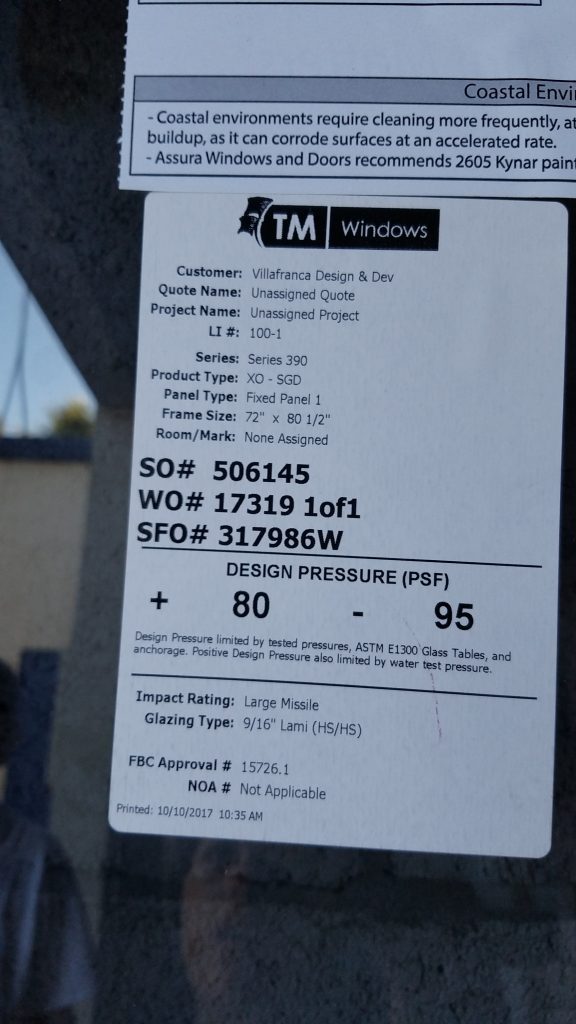
Design Wind Pressure Rating
The pressure rating measures the window’s performance and is expressed as positive and negative wind pressure and is measured in pressure per square foot (PSF). Required design wind pressure is based on wind speed, the surrounding terrain (proximity to the coast, open terrain…etc.), the building height, the size of the window, and the window’s location on the building. An independent laboratory tests the window to 150% of the design pressure rating. Florida Building Code for Risk Category II structures (one-and-two family dwellings and townhouses not more than three stories in height) specifies a wind speed of 175 mph in Miami-Dade County and 170 mph in Broward. The higher the pressure rating, the better.
Energy Performance of Windows
The National Fenestration Rating Council (NFRC) offers a voluntary testing and certification program for thermal performance for windows and residential door products with glass. The NFRC does not conduct structural characteristics, such as impact resistance, but instead serves as a complementary program that can test the whole window (including frame) for the following features: U-Factor, Solar Heat Gain Coefficient (SHGC), Visible Transmittance, Air Leakage, and Condensation Resistance. Remember that just because a window has an NFRC certification label, it does not mean a window or door is energy efficient. Instead, it provides information about energy performance that users can then use to determine if the product is efficient for the region or situation. You’ll note the window sticker contains other information as well, including company name, framing material, product type, etc., so be sure to compare similar products with each other. The SHGC rating is the most important in Florida since we usually try to block the most heat from coming while admitting the most visible light. NFRC Label Solar Heat Gain Coefficient (SHGC) SHGC measures how well a product blocks heat caused by sunlight. The SHGC is the fraction of incident solar radiation admitted through a window, both directly transmitted, absorbed, and subsequently released inward. SHGC is expressed as a number between 0 and 1. The lower a window’s solar heat gain coefficient, the less solar heat it transmits in Florida. Select windows with an SHGC of 0.40 or less.
U-Factor
U-factor measures the amount of heat that escapes through the product. The lower the rating, the better the window prevents heat loss (as imagined, this is more of a concern in northern climates). NFRC certified products require U-factor ratings. In Florida, select windows with a U-factor at least as low as 0.65. Air Leakage* (AL) AL is indicated by an air leakage rating, expressed as the equivalent cubic feet of air passing through a square foot of window area (cfm/sq ft). Heat loss and gain occur by infiltration through cracks in the window assembly. The lower the AL, the less air will pass through cracks in the window assembly.
Condensation Resistance* (CR)
CR measures the ability of a product to resist the formation of condensation on the interior surface of that product. While this rating cannot predict condensation, it can provide a credible method of comparing the potential of various products for condensation formation. CR is expressed as a number between 0 and 100. The higher the CR rating, the better that product is at resisting condensation formation.
Visible Transmittance (VT)
VT measures how much light comes through a product. Visible transmittance is an optical property that indicates the amount of visible light transmitted. VT is expressed as a number between 0 and 1. The higher the VT, the more light is transmitted. * This rating is optional, and manufacturers can choose not to include it.
GM Door, Window & Screen has the most affordable solutions for your home remodeling project. We specialize in the installation of hurricane-ready / impact windows, sliding doors, and entrance doors. In business since 1968, we have been family-owned and operated. GM takes your vision and works within your budget to provide the perfect finished product. Upgrade and make your home safe from storms with new doors, windows, shutters, and more. Call today for a free estimate (954) 797-0797.
